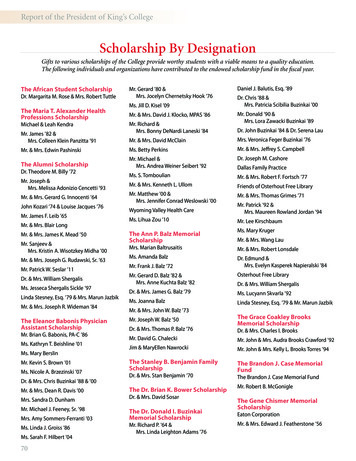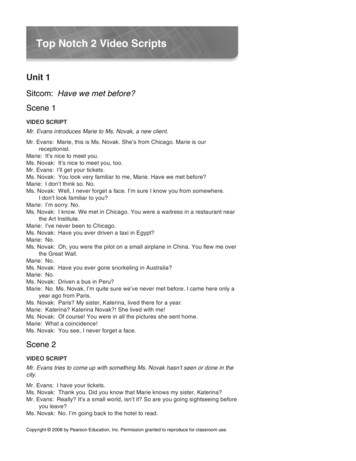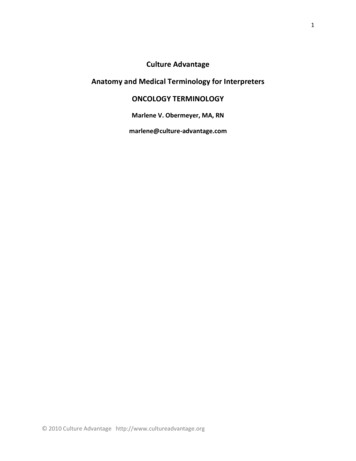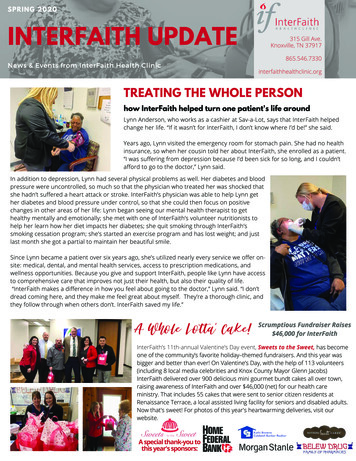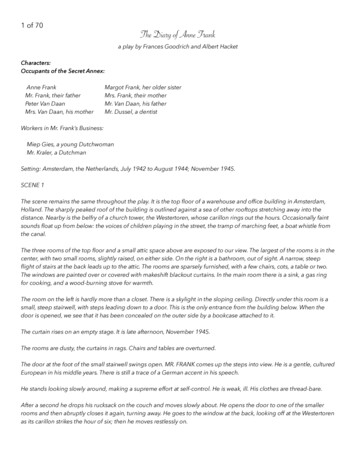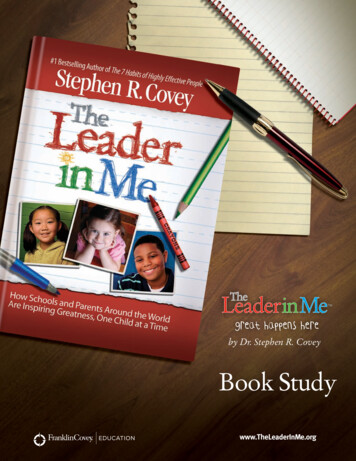
Transcription
by Dr. Stephen R. CoveyBook Studywww.TheLeaderInMe.org
Table of ContentsChapter 1Too Good to Be True?. 2Chapter 2D iscovering What Parents, Business Leaders,and Teachers Want from a School . 4Chapter 3Crafting a Blueprint for Leadership. 6Chapter 4Aligning for Success . 8Chapter 5Unleashing a Culture of Leadership . 10Chapter 6Rippling Across the Globe . 12Chapter 7Moving Upward and Beyond . 14Chapter 8Making It Happen, One Step at a Time . 16Chapter 9Ending With the Beginning in Mind . 18Chapter 10Bringing It Home . 20For the Facilitator . 22The Leader in Me . 25
Book StudyThe Leader in Me by Stephen R. CoveyDiscussion QuestionsChapter 1: Too Good to Be True?Chapter 1 sets the tone of the book and begins to explain how and why leadership principlesare being used in schools around the world.1. Dr. Covey says, “ just entering the front doors of A.B. Combs can be quite an engagingexperience.” What examples did he give? 2. “Engaging” is a powerful word. What word would you use to describe our school?3. What skills do Dr. Covey and others assert that people will need to thrive in the 21st century?4. What is “primary greatness” and how does it differ from “secondary greatness”?5. What are the three overarching themes Dr. Covey challenges us to look for in the schoolexamples found in the book?6. What one thing are you looking forward to reading more about in the remaining chapters?2The Leader in Me Book Study FranklinCovey All rights reserved.
Notes FranklinCovey All rights reserved.The Leader in Me Book Study3
Chapter 2: Discovering What Parents, Business Leaders, and TeachersWant from a SchoolMuriel Summers, principal of A.B. Combs Elementary Magnet School, needed a new focusfor her school. She approached the stakeholders—parents, the business community, teachers,and students. Their responses led Muriel to change the direction of her school.Note: You may want to ask the group to visit www.21stcenturyskills.org prior to this meeting.1. Why did Muriel need to “reinvent her school”? 2. When asked what they wanted from a school, what was the response from parents?3. The business community?4. The teachers?5. The students?6. What do we want for our students?7. What do we already do well? What do we need to do better?8. “To Develop Leaders One Child at a Time” is the mission statement A.B. Combs created.What is the message they hope each child will hear every day?9. Read your school’s mission statement. Ask, “Is our mission statement still relevant? Doesit still resonate with us? Do we need to revisit it?”10. Would you want your child or grandchild to attend a school like A.B. Combs? Why or why not?4The Leader in Me Book Study FranklinCovey All rights reserved.
Notes FranklinCovey All rights reserved.The Leader in Me Book Study5
Chapter 3: Crafting a Blueprint for LeadershipA.B. Combs continued to refine their leadership approach by researching the best ways to teachstudents the skills needed in the 21st century. This chapter identifies their methods and theirblueprint for success.1. Why is it important for the vision and mission to be visible to everyone? 2. What connections are you making between character and the 7 Habits?3. Independence is an important accomplishment for a child. Why not stop there?4. How is the ubiquitous approach different from other initiatives?5. What do “quality tools” bring to the table?6. What are the key benefits of using Data Notebooks?7. What might be different if students set individual goals based on their own previous scoresinstead of competing with others?8. What idea found in this chapter have you already used? What new idea will you use?9. A.B. Combs uses a foundation of 7 Habits and Baldrige Tools. However, they stay abreast ofnew educational methods and incorporate them if they align with their vision and mission. Onpage 67 is the schoolhouse model A.B. Combs uses. What would currently be in our schoolhousewindows? (You may want to draw a schoolhouse and write in the group’s answers.)10. The success of A.B. Combs is built on a culture of caring and respect. How do we currentlyshow our students, and each other, caring and respect? What are other ways we could showour students, and each other, caring and respect?21st Century SkillsRigor, Relevance,& Relationshipsthe essential 55the 7 habits6The Leader in Me Book Study7 correlatesof The Leader inMe” ProcessbrainresearchEmotionalintelligencebaldrige tools FranklinCovey All rights reserved.
Notes FranklinCovey All rights reserved.The Leader in Me Book Study7
Chapter 4: A ligning for SuccessMore often than not, great initiatives are not sustainable due to systems and processesnot being in place to sustain excellence. A.B. Combs took the time to review each of theirstrategies and determine whether they aligned with their new leadership theme. Some strategiescontinued, while others were replaced or discontinued.1. The first task the school undertook was to make sure every teacher was on board. This wasa difficult task as there were some who were resistant. Reluctant staff can sometimes makea positive contribution. How is that possible? 2. How would placing the word “leader” after a title impact a person’s image of himself or herself?3. D r. Covey mentions that the end in mind at A.B. Combs is to unleash the potential of eachchild and staff member. “This has brought artistry back to their [the teachers’] careers.”How do you see this manifesting itself in your teaching?4. How has empowering teachers and students changed the administrators’ day?5. Why was it important that all staff, not just teachers, be trained in the 7 Habits the first year?6. How do the 7 Habits help with discipline issues?7. Many change efforts in schools fail. A.B. Combs paused to review four components andit made all the difference. What are the four components? Why would reviewing each ofthese make a difference?8. What barriers might we encounter? How will we handle these barriers?8The Leader in Me Book Study FranklinCovey All rights reserved.
Notes FranklinCovey All rights reserved.The Leader in Me Book Study9
Chapter 5: U nleashing a Culture of LeadershipThis chapter discusses the culture change of A.B. Combs and what was involved leadingup to their success.1. How is “culture” defined in the book? 2. How would you describe our current culture?3. E ach year, A.B. Combs takes the entire first week to establish the culture of the school.What are the pros and cons of this approach? In your opinion, is it time well spent?4. How is the leadership language seen and heard throughout the building?5. T he artifacts or environment of A.B. Combs screams leadership and student involvement.What daily impact do you think this has on students, staff, and visitors?6. Traditions play a large part at the school. Which of the traditions listed would be the oneyou would be most excited to adopt? Why?7. Closing activity: Hand out a square piece of paper to each participant and ask themto write something in each corner that “squares” with their beliefs.10The Leader in Me Book Study FranklinCovey All rights reserved.
Notes FranklinCovey All rights reserved.The Leader in Me Book Study11
Chapter 6: R ippling Across the GlobeMoving past A.B. Combs, this chapter highlights other elementary schools that have adoptedThe Leader in Me.1. Like A.B. Combs, English Estates Elementary School spends the majority of the first two weeksof school teaching students the 7 Habits and establishing goals and expectations for the year.As a teacher, how much time do you predict this would save each day? each year? What couldyou do with the additional time? 2. What does it say about the culture of the school when, given bonus funds, the parents gaveit to the teachers and the teachers shared it with all staff?3. The principal of English Estates was asked, “With all the pressure to perform academically, howdid you dare choose to work first on changing the culture?” She responded, “Because it feltlike the right thing to do.” However, their academic scores improved. Why do you think that is?4. What impact does a “common language” have on a group? Why?5. Why do you think so many children use the 7 Habits at home, as reported by their parents?6. Learning anything new takes additional energy, yet the teachers in the book continueto say that they were energized by the new initiative. How is that possible?7. Many of the schools also included parents in their 7 Habits training. What might be thebenefit of offering training to parents?8. Each of the schools mentioned in the book incorporates The Leader in Me in a way thatis best suited for their school. Why do you think Dr. Covey makes that point?12The Leader in Me Book Study FranklinCovey All rights reserved.
Notes FranklinCovey All rights reserved.The Leader in Me Book Study13
Chapter 7: Moving Upward and Beyond In this chapter, Dr. Covey sites examples of middle schools, high schools, and districtsthat have taken on a leadership focus using the 7 Habits.1. At Joliet High School, Tony Cantos was ready to abandon his career in education. From whatyou have read so far, how do you think the 7 Habits “reignited” his passion for education? 2. Noble Street High School takes on social issues and asks students to apply the 7 Habits.How might this real-life application impact a class discussion?3. W hat are some of the creative ways the middle and high schools cited in the book havebrought the 7 Habits to their staff and students?4. How long do you think it will be before the impact of the “Path of Dreams” program inGuatemala will begin to change the culture of the country?5. In your opinion, how would the 7 Habits affect our test scores as they did in Japan?6. What are the advantages of a school staff working as a team rather than in isolation?7. What might be the students’ reaction when they realize that a particular class, focusedon the 7 Habits, is about them—and their life?8. In a middle or high school, where is the best placement for the 7 Habits content?9. D o you think parenting middle or high school students who know the 7 Habits content wouldbe less stressful? Why?14The Leader in Me Book Study FranklinCovey All rights reserved.
Notes FranklinCovey All rights reserved.The Leader in Me Book Study15
Chapter 8: Making It Happen, One Step at a Time Dr. Covey explains four sequential, principle-based steps that can help guide the effortof implementing a leadership theme in a school.1. What are the four steps Dr. Covey recommends to facilitate change? 2. What are the benefits of a culture that has high trust?3. On a scale of 1 to 10, how would you rate the current trust level in our building?4. The “Pyramid of Influence” shows teaching at the top, and stresses that modeling and relatingneed to be strong for teaching to be most effective. Do you agree? Why?5. How does individual and group behavior change when there is a clear, unified purpose?6. What step is most often overlooked when initiating change?7. What is meant by “Teachers are a school’s greatest asset, which also makes themthe greatest threat”?8. How is leadership defined in Chapter 8?9. I f you were empowered to teach using your own unique gifts and talents, what would bedifferent? Would you be inspired? Would your passion for your profession be renewed? onsider a past program that we no longer use. Since you just read about sustaining change,10. Cwhat was it about how that program was initiated that made it unsustainable?11. Using the Jigsaw Method (see Facilitator Notes), divide the larger group into four smallergroups. Using The 4 Imperatives of Leadership found on pages 166–183, ask each groupto be ready to share “Assumptions,” “Agree,” “Argue,” and “Aspire to Apply” withthe larger group.The Pyramid ofInfluenceHeardFeltSeen16The Leader in Me Book StudygTeachinRelatingngModeli FranklinCovey All rights reserved.
Notes FranklinCovey All rights reserved.The Leader in Me Book Study17
Chapter 9: E nding With the Beginning in MindKey content and the spirit of the book are takeaways from this chapter. Four key phrases,as well as the overarching concepts from the previous chapters, are presented and offer agood place to begin the discussion of where you are, where you would like to be, and thebest path to get there.1. The first phrase Dr. Covey wants us to remember is “modern-day miracle worker.” What mightchange in the way you interact with children if the paradigm you had of yourself was that of amodern-day miracle worker? 2. What examples of being modern-day miracle workers are given of Muriel, the teachers atA.B. Combs, and the other educators in the book?3. What are we currently doing that shows a “Tradition of Caring” at our school?4. What could we do to encourage this tradition?5. “Not one more thing” is a phrase echoed by the teachers in leadership schools. Why do youthink they feel that way?6. In fact, several times teachers comment that the leadership focus actually saves them time.Do you think they felt that way in the beginning? What do you think happened that movedthem to that comment?7. Do you feel that the “universal nature” of the 7 Habits would apply to our schoolcommunity—students, staff, and parents? Why? mbedded in the four phrases are keys to success of the leadership theme. I would like8. Eyou to discuss each point for 5 minutes at your table. Discuss whether you agree withthe statement and, if so, how you would go about accomplishing it. Individual teachers unleashing the potential of students all over the world, one child at a time A schoolwide effort with all stakeholders engaged and contributing Emphasis on focusing on what is most important to be teaching Emphasis on teaching timeless principles and skills that are relevant to today’s global realityand preparatory for what tomorrow will bring9. Closing activity: Hand out a paper circle to each participant and ask them to take a “strategicpause” and write the thoughts that keep going round and round in their heads.18The Leader in Me Book Study FranklinCovey All rights reserved.
Notes FranklinCovey All rights reserved.The Leader in Me Book Study19
Chapter 10: Bringing It HomeThe final chapter discusses the powerful influence the home has on a child’s life. Althoughteachers will gain many ideas to encourage leadership, Dr. Covey is mainly addressing parentsin this chapter.1. What does Dr. Covey mean by “The cultural or social DNA is the great identity thief, not theperson who steals and uses your credit card”? 2. You may notice that the four steps for initiating change in the home are identical to thefour steps suggested for school. What are some of the ways we could inspire parents togo through the same process at home while we are going through it at school?3. I n Chapter 10 there are several suggestions parents can use for each of the habits. What wouldbe the best way to communicate these ideas to parents? What is our end in mind? he Leader in Me schools have a mission statement, the classrooms have a mission statement,4. Tand the students often have a Personal Mission Statement. How could we guide our studentsto help their families write a Family Mission Statement?5. Dr. Covey recommends three tips to preparing children for the new reality. What are they?6. Do you think the parents would be interested in an informational parent night?20The Leader in Me Book Study FranklinCovey All rights reserved.
Notes FranklinCovey All rights reserved.The Leader in Me Book Study21
For the FacilitatorDefinition of a Book Study:A group of people who meet regularly to discuss a book they are reading.General Tips: R ead the book. This may seem obvious, but it is the most important step, so it is worth stating.It is a good idea to plan on finishing each chapter a little earlier than you might do otherwise sothat you have time to think about it and prepare before meetings. Write down important page numbers. If there are parts of the book that made an impacton you or that you think may come up in discussion, write down the page numbers so that youcan access the passages easily while preparing and leading the discussion. Let others answer first. When you are asking questions, you want to facilitate discussion.By letting others answer first, you will promote conversation and help everyone feel like theiropinions matter. Note: Sometimes people may need to think before they answer. Part of beinga good facilitator is being comfortable with silence. Don’t feel like you have to jump in if no oneanswers immediately. et everyone involved. Each member should assume responsibility for the success of theGdiscussion. To keep the conversation moving, ask participants to elaborate or explain more fullya previous comment or to restate their comment in a different way. Encourage participants torelate the contents to their own experiences. Encourage participants to question and comment. Participants should be encouraged towrite questions and comments while they are reading and bring them to each meeting. Make connections between comments. If someone gives an answer to Question 2 thatconnects well with Question 5, don’t feel obligated to ask Questions 3 and 4 before moving to 5.You are the facilitator. Even if you go in order, try to find a link between an answer and the nextquestion. By connecting people’s comments to the questions, you’ll help build momentum in theconversation. Occasionally, direct questions toward quiet people. You don’t want to put anyone onthe spot, but you want everyone to know their opinions are valued. If you have a few talkativepeople who always jump right in, directing a question to a specific person may help draw out thequieter people (and let the talkative people know it is time to give someone else a turn). Plan strategies for refocusing. Keep the discussion “on track” and solicit ideas andcomments from all participants. If a discussion veers off track, offer to discuss it after the meetingwith anyone who is interested. Don’t feel obligated to get through all the questions. The best questions sometimeslead to intense conversations. That’s a good thing! The questions are there as a guide. It maybe rare that you finish all of the questions. Respect people’s time by wrapping up the discussionwhen the meeting time is over rather than pushing on until you finish everything you planned. 22Close each session. Plan a summarizing activity, question, or assignment.The Leader in Me Book Study FranklinCovey All rights reserved.
Structuring the DiscussionYou may choose to use some of the following “discussion starters” as you facilitate thediscussion. Partner Interviews. Participants interview one another to get different viewpoints on a topic. Jigsaw. (Places great emphasis on cooperation and shared responsibility within groups.)1. Divide the group into smaller groups.2. Divide the chapter(s) of reading into roughly equal parts.3. Assign each smaller group one of the parts.4. At the following meeting, have each small group discuss their part and come to a consensuson the main points to share with the larger group.5. Make sure everyone participates. Table Talk. Allow for discussion at each table with the intent to share with the larger groupafter a specific time period. PowerPoint . Pose a question on the screen and collect whole-group feedback on a poster.Opening the Meetings Ask members for a great idea they tried that was successful, or A question they may have and need help finding the answer to. FranklinCovey All rights reserved.The Leader in Me Book Study23
For the FacilitatorConcluding the Book Study.Instruct participants to write what they have learned from the book on stickynotes. Place each sticky note on a large chart paper that has been dividedinto sections such as “My Ideal School,” “Potential,” “Student Leadership,”“Teaching Strategies,” “Culture,” “Parents,” “Change,” etc.Decide Next StepsDecide whether the group would like to know more about The Leader in Me process. Whatshould be our next steps? Who24The Leader in Me Book Studyis responsible for the next steps? FranklinCovey All rights reserved.
Will Your School or ChildBe the Next The Leader in MeSuccess Story?Drawing from the best practices and thought leadership of successful educatorsaround the world, FranklinCovey’s The Leader in Me process will help schoolsdevelop students who are ready to succeed in the 21st century, with critical skillsand characteristics such as: Trust and trustworthiness Effective interpersonal skills Strong work ethic Sense of teamwork Motivation and initiative Valuing diversity in aglobal market Problem-solving skills Goal settingWhat’s more, schools will enjoy a culture in whichdiscipline referrals decrease, test scores improve,and engaged staff members contribute the highestand best of their talents and efforts.What is the process for getting started with The Leader in Me?Inspire Vision Day to create a visionfor greatness and inspireengagement from teachersand staff.Engage The 7 Habits of Highly EffectivePeople adapted for the educationenvironment.integrate Implementation, including trainingand a rich set of guides andonline tools to help integrate theprinciples of greatness into theschool’s existing core curriculum.Help put the schools in your community on the path to greatness.For more information about how investing in The Leader in Me can help put the schools inyour community on the path to greatness, please contact FranklinCovey’s Education Solutionsby calling 1-800-272-6839 or by email at Educate@FranklinCovey.com. Or visit www.theleaderInMe.org.You can also visit www.franklincovey.com/education. FranklinCovey All rights reserved.The Leader in Me Book Study25
7 6 0 5 8The Leader in Me Book Study FranklinCovey. All rights reserved.76058Made in U.S.A. FranklinCoveyEDU101108 Version 1.0.0
The Leader in Me by Stephen R. Covey Discussion Questions Chapter 1: Too Good to Be True? Chapter 1 sets the tone of the book and begins to explain how and why leadership principles are being used in schools around the world. 1. Dr. Covey says, “ just entering the front
